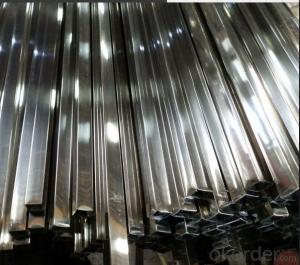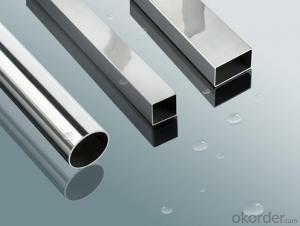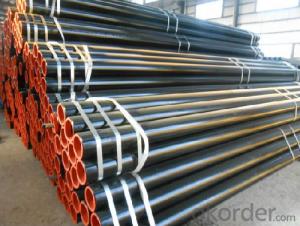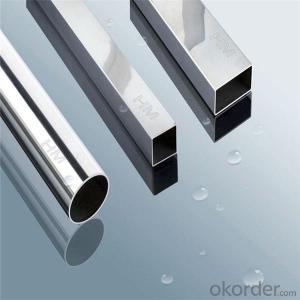STAINLESS STEEL PIPES 201 & 410 pipes
- Loading Port:
- China Main Port
- Payment Terms:
- TT OR LC
- Min Order Qty:
- -
- Supply Capability:
- -
OKorder Service Pledge
OKorder Financial Service
You Might Also Like
Description:
Stainless Steel Pipe
Material:
304 321 316 310
Packing:
In bundle
MOQ:
5 TONS
Comparison of standardized steels
| EN-standard Steel no. k.h.s DIN | EN-standard Steel name | SAE grade | UNS |
|---|---|---|---|
| 1.4109 | X65CrMo14 | 440A | S44002 |
| 1.4112 | X90CrMoV18 | 440B | S44003 |
| 1.4125 | X105CrMo17 | 440C | S44004 |
| | | 440F | S44020 |
| 1.4016 | X6Cr17 | 430 | S43000 |
| 1.4408 | G-X 6 CrNiMo 18-10 | 316 | |
| 1.4512 | X6CrTi12 | 409 | S40900 |
| | | 410 | S41000 |
| 1.4310 | X10CrNi18-8 | 301 | S30100 |
| 1.4318 | X2CrNiN18-7 | 301LN | |
| 1.4307 | X2CrNi18-9 | 304L | S30403 |
| 1.4306 | X2CrNi19-11 | 304L | S30403 |
| 1.4311 | X2CrNiN18-10 | 304LN | S30453 |
| 1.4301 | X5CrNi18-10 | 304 | S30400 |
| 1.4948 | X6CrNi18-11 | 304H | S30409 |
| 1.4303 | X5CrNi18-12 | 305 | S30500 |
| | X5CrNi30-9 | 312 | |
| 1.4541 | X6CrNiTi18-10 | 321 | S32100 |
| 1.4878 | X12CrNiTi18-9 | 321H | S32109 |
| 1.4404 | X2CrNiMo17-12-2 | 316L | S31603 |
| 1.4401 | X5CrNiMo17-12-2 | 316 | S31600 |
| 1.4406 | X2CrNiMoN17-12-2 | 316LN | S31653 |
| 1.4432 | X2CrNiMo17-12-3 | 316L | S31603 |
| 1.4435 | X2CrNiMo18-14-3 | 316L | S31603 |
| 1.4436 | X3CrNiMo17-13-3 | 316 | S31600 |
| 1.4571 | X6CrNiMoTi17-12-2 | 316Ti | S31635 |
| 1.4429 | X2CrNiMoN17-13-3 | 316LN | S31653 |
| 1.4438 | X2CrNiMo18-15-4 | 317L | S31703 |
| 1.4362 | X2CrNi23-4 | 2304 | S32304 |
| 1.4462 | X2CrNiMoN22-5-3 | 2205 | S31803/S32205 |
| 1.4539 | X1NiCrMoCu25-20-5 | 904L | N08904 |
| 1.4529 | X1NiCrMoCuN25-20-7 | | N08926 |
| 1.4547 | X1CrNiMoCuN20-18-7 | 254SMO | S31254 |
Stainless steel’s resistance to corrosion and staining, low maintenance and familiar lustre make it an ideal material for many applications. There are over 150 grades of stainless steel, of which fifteen are most commonly used. The alloy is milled into coils, sheets, plates, bars, wire, and tubing to be used in cookware, cutlery, household hardware, surgical instruments, major appliances, industrial equipment (for example, in sugar refineries) and as an automotive and aerospace structural alloy and construction material in large buildings. Storage tanks and tankers used to transport orange juice and other food are often made of stainless steel, because of its corrosion resistance. This also influences its use in commercial kitchens and food processing plants, as it can be steam-cleaned and sterilized and does not need paint or other surface finishes.
Stainless steel is used for jewelry and watches with 316L being the type commonly used for such applications. It can be re-finished by any jeweler and will not oxidize or turn black.
Some firearms incorporate stainless steel components as an alternative to blued or parkerized steel. Some handgun models, such as the Smith & Wesson Model 60 and the Colt M1911 pistol, can be made entirely from stainless steel. This gives a high-luster finish similar in appearance to nickel plating. Unlike plating, the finish is not subject to flaking, peeling, wear-off from rubbing (as when repeatedly removed from a holster), or rust when scratched.
Architecture[edit]
Stainless steel is used for buildings for both practical and aesthetic reasons. Stainless steel was in vogue during the art deco period. The most famous example of this is the upper portion of the Chrysler Building (pictured). Some diners and fast-food restaurants use large ornamental panels and stainless fixtures and furniture. Because of the durability of the material, many of these buildings retain their original appearance.
Type 316 stainless is used on the exterior of both the Petronas Twin Towers and the Jin Mao Building, two of the world's tallest skyscrapers.[17]
The Parliament House of Australia in Canberra has a stainless steel flagpole weighing over 220 tonnes (240 short tons).
The aeration building in the Edmonton Composting Facility, the size of 14 hockey rinks, is the largest stainless steel building in North America.
Bridges[edit]
Cala Galdana Bridge in Minorca (Spain) was the first stainless steel road bridge.
Sant Fruitos Pedestrian Bridge (Catalonia, Spain), arch pedestrian bridge.
Padre Arrupe Bridge (Bilbao, Spain) links the Guggenheim museum to the University of Deusto.[18]
Monuments and sculptures[edit]
The Unisphere, constructed as the theme symbol of the 1964-5 World's Fair in New York City, is constructed of Type 304L stainless steel as a sphere with a diameter of 120 feet, or 36.57 meters.
The Gateway Arch (pictured) is clad entirely in stainless steel: 886 tons (804 metric tonnes) of 0.25 in (6.4 mm) plate, #3 finish, type 304 stainless steel.[19]
The United States Air Force Memorial has an austenitic stainless steel structural skin.
The Atomium in Brussels, Belgium was renovated with stainless-steel cladding in a renovation completed in 2006; previously the spheres and tubes of the structure were clad in aluminium.
The Cloud Gate sculpture by Anish Kapoor, in Chicago US.
The Sibelius monument in Helsinki, Finland, is made entirely of stainless steel tubes.
The Man of Steel (sculpture) under construction in Rotherham, England.
Other[edit]
- Automotive bodies
The Allegheny Ludlum Corporation worked with Ford on various concept cars with stainless steel bodies from the 1930s through the 1970s, as demonstrations of the material's potential. The 1957 and 1958 Cadillac Eldorado Brougham had a stainless steel roof. In 1981 and 1982, the DeLorean DMC-12 production automobile used stainless steel body panels over a glass-reinforced plasticmonocoque. Intercity buses made by Motor Coach Industries are partially made of stainless steel. The aft body panel of the Porsche Cayman model (2-door coupe hatchback) is made of stainless steel. It was discovered during early body prototyping that conventional steel could not be formed without cracking (due to the many curves and angles in that automobile). Thus, Porsche was forced to use stainless steel on the Cayman.
- Passenger rail cars
Rail cars have commonly been manufactured using corrugated stainless steel panels (for additional structural strength). This was particularly popular during the 1960s and 1970s, but has since declined. One notable example was the early Pioneer Zephyr. Notable former manufacturers of stainless steel rolling stock included the Budd Company (USA), which has been licensed to Japan's Tokyu Car Corporation, and the Portuguese company Sorefame. Many railcars in the United States are still manufactured with stainless steel, unlike other countries who have shifted away.
- Aircraft
Budd also built an airplane, the Budd BB-1 Pioneer, of stainless steel tube and sheet, which is on display at the Franklin Institute.
The American Fleetwings Sea Birdamphibious aircraft of 1936 was also built using a spot-welded stainless steel hull.
The Bristol Aeroplane Company built the all-stainless steel Bristol 188 high-speed research aircraft, which first flew in 1963.
The use of stainless steel in mainstream aircraft is hindered by its excessive weight compared to other materials, such as aluminum.
- Jewelry
Valadium, a stainless steel and 12% nickel alloy is used to make class and military rings. Valadium is usually silver-toned, but can be electro-charged to give it a gold tone. The gold tone variety is known as Sun-lite Valadium
- Q: Can stainless steel pipes be used for steam transportation?
- Yes, stainless steel pipes are commonly used for steam transportation due to their high resistance to corrosion and ability to withstand high temperatures.
- Q: What is the difference between Schedule and Nominal Pipe Sizes for stainless steel pipes?
- The difference between Schedule and Nominal Pipe Sizes for stainless steel pipes lies in their respective measurements. Schedule refers to the wall thickness of the pipe, while Nominal Pipe Size (NPS) indicates the approximate inside diameter of the pipe. The Schedule system is based on a standard thickness range, denoted by a specific number, such as Schedule 40 or Schedule 80, which are commonly used in industrial applications. On the other hand, NPS provides a standardized label for pipes that corresponds to a specific inside diameter, regardless of the wall thickness. Therefore, while Schedule determines the strength and pressure rating of a stainless steel pipe, NPS primarily denotes its size for compatibility with fittings and other components.
- Q: Are stainless steel pipes resistant to stress corrosion cracking?
- Yes, stainless steel pipes are highly resistant to stress corrosion cracking due to their inherent corrosion resistance properties.
- Q: Can stainless steel pipes be used in food processing industries?
- Yes, stainless steel pipes are commonly used in food processing industries. Stainless steel is a highly durable and corrosion-resistant material that is capable of withstanding the harsh environments and high temperatures often found in food processing plants. It is also non-reactive, meaning that it does not interact with the food or alter its taste, making it a safe choice for transporting various food products. Additionally, stainless steel pipes are easy to clean and maintain, ensuring hygiene standards are met in the food processing industry.
- Q: Are stainless steel pipes resistant to scaling?
- Yes, stainless steel pipes are resistant to scaling. Scaling refers to the formation of a hard, thick layer of mineral deposits on the inner surface of pipes, which can reduce their efficiency and restrict the flow of fluids. Stainless steel pipes have a high resistance to scaling due to their composition, which typically includes chromium. The presence of chromium forms a protective oxide layer on the surface of the pipe, preventing the formation of scale and ensuring long-term durability. Additionally, stainless steel pipes have excellent corrosion resistance, making them suitable for a wide range of applications where scaling may occur.
- Q: What is the hardness of stainless steel pipes?
- The specific grade and treatment of the steel can cause variations in the hardness of stainless steel pipes. Stainless steel pipes exhibit a range of hardness levels, which are typically assessed using either the Rockwell scale or the Brinell scale. The hardness of stainless steel pipes surpasses that of other steel types due to the presence of alloying elements like chromium and nickel, which enhance resistance to corrosion and wear. Ordinarily, stainless steel pipes fall within the hardness range of 75 to 180 on the Rockwell scale or 150 to 300 on the Brinell scale. Nonetheless, it's worth noting that factors such as heat treatment, welding, and cold working processes can also affect the hardness.
- Q: Are stainless steel pipes resistant to scaling and oxidation?
- Yes, stainless steel pipes are highly resistant to scaling and oxidation due to the presence of chromium in their composition, which forms a protective oxide layer on the surface, preventing corrosion and scaling.
- Q: What are the different sizes available for stainless steel pipes?
- Stainless steel pipes are available in a wide range of sizes to cater to various industrial and residential applications. The sizes of stainless steel pipes typically depend on their nominal pipe size (NPS) or outside diameter (OD). The most common sizes for stainless steel pipes range from 1/8 inch to 48 inches in diameter. For smaller applications or plumbing systems, stainless steel pipes with NPS 1/8, 1/4, 3/8, and 1/2 are commonly used. These sizes are ideal for household plumbing, water supply lines, and low-pressure applications. As the requirements increase, larger stainless steel pipe sizes are available. Sizes such as NPS 3/4, 1, 1 1/4, 1 1/2, and 2 inches are commonly used in various industries and commercial applications. These sizes are suitable for higher-pressure applications like hydraulic systems, oil and gas pipelines, and chemical processing plants. For industrial applications that require even larger pipes, stainless steel pipes with sizes ranging from 2 1/2 inches to 48 inches in diameter are available. These large pipes are often used in heavy-duty applications such as petrochemical plants, power generation facilities, and large-scale construction projects. It's important to note that stainless steel pipes are also available in different wall thicknesses, commonly referred to as schedules. The schedule number determines the wall thickness, with higher numbers indicating thicker walls. The most common schedules for stainless steel pipes are Schedule 5, Schedule 10, Schedule 40, and Schedule 80. In summary, stainless steel pipes come in a wide range of sizes, starting from 1/8 inch and going up to 48 inches in diameter. The selection of the appropriate size depends on the specific application and the required pressure and flow requirements.
- Q: What are stainless steel pipes used for?
- Stainless steel pipes are commonly used in various industries and applications due to their durability, corrosion resistance, and high strength. They are primarily used for transporting fluids and gases such as water, oil, gas, and chemicals. Additionally, stainless steel pipes find extensive use in plumbing systems, construction projects, automotive applications, food processing plants, pharmaceutical industries, and manufacturing processes where hygiene, reliability, and longevity are crucial.
- Q: Can stainless steel pipes be insulated with polyimide?
- Indeed, polyimide is a suitable material for insulating stainless steel pipes. Its exceptional thermal stability, electrical insulation properties, and resistance to chemicals have made it highly sought-after in numerous industries. With the ability to endure high temperatures and exhibit low thermal conductivity, polyimide proves to be an optimal selection for insulating stainless steel pipes, particularly in scenarios where heat resistance and energy preservation are critical. By implementing polyimide insulation, heat transfer can be minimized, condensation can be avoided, and the overall efficiency and performance of stainless steel pipes can be enhanced.
Send your message to us
STAINLESS STEEL PIPES 201 & 410 pipes
- Loading Port:
- China Main Port
- Payment Terms:
- TT OR LC
- Min Order Qty:
- -
- Supply Capability:
- -
OKorder Service Pledge
OKorder Financial Service
Similar products
Hot products
Hot Searches
Related keywords




















